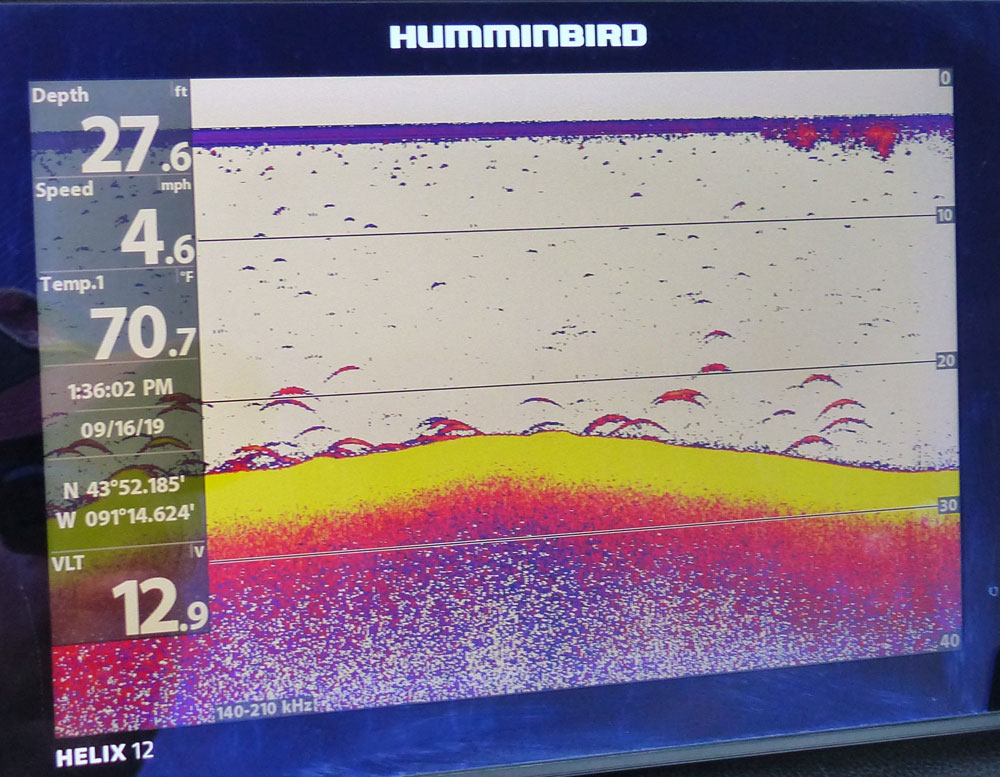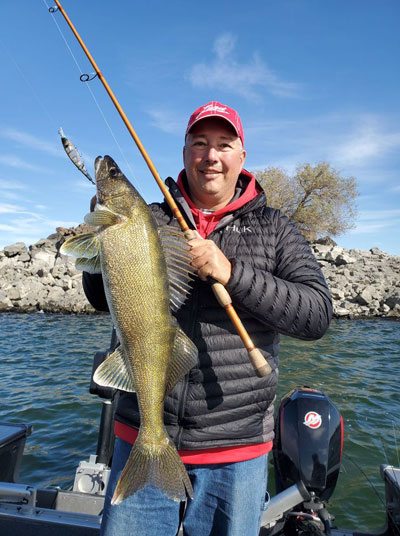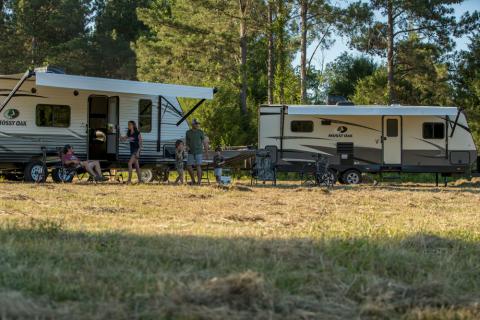provided by John E. Phillips
Mossy Oak Pro Johnnie Candle of Devils Lake, North Dakota, has been a tournament walleye fisherman for many years. When not tournament fishing, he guides on Devils Lake in North Dakota and several other lakes. To learn more, check out his website and his Facebook page.

I start walleye fishing in late March or early April each year. But I won’t be fishing my home lake of Devils Lake in North Dakota then. I’ll be probably be fishing lakes south and east of where I live - more than likely a Great Lakes state or down in Iowa, Nebraska or South Dakota where the waters are somewhat warmer than Devils Lake. I’ll probably be fishing moving water like a river as the rivers thaw out. Rivers generally thaw out much quicker than lakes do.
My number-one choice for March walleyes is the Detroit River in Michigan that flows into Lake Erie. It holds a phenomenal run of walleyes coming from Lake Erie during the early spring. My number-two selection will be around Bismarck, North Dakota, on the Missouri River that thaws early and has a huge run of walleyes that come out of Lake Oahe. That reservoir fills up in most of South Dakota. The walleyes run very thick in the Missouri River there. It’s a phenomenal place to fish for walleyes in the early spring.
My third pick will be Lake Francis Case near Chamberlain, South Dakota. The walleyes there aren’t as big as in other places, but the weather is usually nice in the spring. There’s also a lot of eating-size walleyes in the 16-18-inch range in that lake. This lake is a great place to knock the rust off your rod in the spring and get your line stretched. Then you can make sure your equipment will work well for the rest of walleye season.
Whether I’m guiding, tournament fishing or fishing for fun, I know you’ll not get to be as good a walleye angler as you want to be until you’ve tested your skills on numbers of different walleye waters. The only way I’ve been able to get that confidence is to trust what my sonar is showing me. Technology has made using sonar so much easier than ever before in the past. Down-color sonar can show you incredible photos of what’s under your boat as far as fish and structure. Then with the side-imaging and forward-imaging sonar, the walleyes have no place to hide that we can’t find them.
 There are so many buttons and different screens on the newer electronics, it can be hard to learn how to operate these electronics to be proficient enough and to have the confidence you need to fish a new lake. There are a couple of things you can do to learn to run your new depth finder. The best is to spend time on the water reading instructions for your depth finder and learning how to operate it. But the hardest thing for most anglers to do is to take their boats with their new sonar out on a lake and leave all their rods at home to keep them from fishing. If you truly want to learn how to run a new depth finder, then take every rod and reel out of your boat, get out on the lake, and start working with your depth finder.
There are so many buttons and different screens on the newer electronics, it can be hard to learn how to operate these electronics to be proficient enough and to have the confidence you need to fish a new lake. There are a couple of things you can do to learn to run your new depth finder. The best is to spend time on the water reading instructions for your depth finder and learning how to operate it. But the hardest thing for most anglers to do is to take their boats with their new sonar out on a lake and leave all their rods at home to keep them from fishing. If you truly want to learn how to run a new depth finder, then take every rod and reel out of your boat, get out on the lake, and start working with your depth finder.
Two other shortcuts are available to this system. You can hire a guide who uses a depth finder like yours, pay him a guide’s fee to take you fishing but make learning to use your depth finder more important than catching walleyes. You can catch a few fish, but remember that’s not why you’ve hired the guide. The number-one thing you’ve hired that guide to do is to shortcut the learning curve for you to become as proficient as you possibly can be with your new depth finder. Then the next time you go out in your boat with your depth finder, again leave the rods at home. If you find the mother lode of walleyes, you’ll spend more time trying to catch those walleyes than you will learning about your depth finder. When Humminbird comes out with new features and a new depth finder, the first thing I do is take my rods out of my boat and spend the day learning how to take advantage of the newest features on that depth finder.
The other shortcut to learning how to use a new depth finder is to attend a seminar. Luckily, quite a few seminars and classes are being held on how to use the newest depth finders on the market. Last year before COVID-19 struck, I taught 13 classes on how to use the new Humminbird depth finder. The year before, I taught more than 20 classes on how to use the latest Humminbird depth finder.
I’m just one guy, but there are tons of people all across the U.S. teaching classes on how to use the latest Humminbird, Lowrance and Garmin depth finders. These classes will cost from as little as $20 per person up to $50-$100 per person. However, if you’ve spent several thousand dollars to get the latest and greatest depth finder, that’s not much money to spend to learn how to push the buttons, look at all the screens and be able to interpret what you see.
Johnnie Candle’s Walleye Lasagna Recipe
Ingredients:
- 1 box of lasagna noodles
- 1 medium white onion, chopped
- 1 teaspoon minced garlic
- 2 Tablespoons butter
- 2 packets Alfredo sauce
- 6 ounces Ricotta cheese
- 4 cups shredded mozzarella cheese
- 2 cups parmesan cheese
- Hand full of fresh spinach leaves
- 8 – 10 medium walleye fillets
- Salt and pepper to taste
Preparation:
Boil lasagna noodles according to directions. Stir together ricotta and shredded mozzarella cheeses. Prepare Alfredo sauce according to the package directions. In frying pan sauté onions and garlic in butter, add fish and flake apart, and salt and pepper to taste.
Layer in 9X13 pan. Put a small amount of sauce in bottom of pan, 3 noodles, one half of cheese mixture, one-half of the fish, a single layer of fresh spinach, sauce, 3 more noodles, and repeat. Top with 1 cup parmesan cheese, and bake covered at 350 degrees for 40 minutes. Uncover, and sprinkle remaining 1 cup parmesan cheese on top. Bake uncovered 10 minutes. Let stand 15 minutes before serving.



























